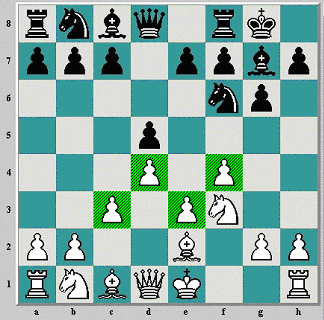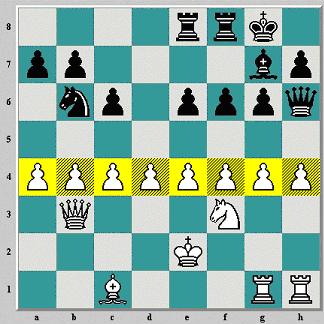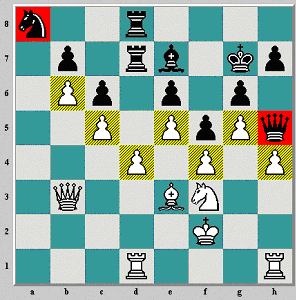The Alterman Wall
Alterman,B (2564) - DEEP FRITZ [A03]
1.f4 My idea was to get the Stonewall set-up, with
all the pawns remaining on the board. Another way to achieve
the same formation would have been with 1.d4 d5 2.e3, but then
2...Bf5 gives Black a comfortable game, without the need to
build a kingside fianchetto. After 1.f4, White's biggest
danger is 1...e5. In that case I intended to play 2.fxe5 d6
3.exd6 Bxd6 4. Nf3 g5 5.d4 g4 6.Ne5, offering Black the ending
ensuing after 6...Bxe5. In other words, to give back the pawn
in order to swap queens. 1...d5 2.Nf3 Nf6 3.e3 g6 4.Be2 Bg7
5.d4 0–0 6.c3

This is not a new formation. I've played a lot of
lightning games with the same set-up, and the location of the
bishop on e2 (instead of d3) is of no significance. White's
main objective is to keep all the pieces on the board, since
the more pieces remaining on the board, the more calculations
are required for the computer after each move, decreasing its
ability to focus on the crucial lines. The calculations become
very complicated for the computer under such conditions.
6...Bf5 7.Nbd2 In order to eliminate any possibility of
capturing on b1. 7...e6?! The first evidence that it is
playing without a plan. Natural was 7...c5. After the text
move the possibilities of Bf5 are limited. 8.h3 Ne4? A
mistake. He should have kept this square for his bishop.
Fritz's colleague, Deep Junior, tends to play 8...h5? in such
positions. However, this also would have been a serious
mistake, as it desperately weakens the kingside. 9.g4 Ng3?
Losing a pawn. After the alternative, 9...Nxd2 10.Nxd2 Be4
11.Nxe4 dxe4 12.h4, White has a clear positional advantage
thanks to the pair of bishops, the strong center, and the
excellent attacking possibilities on the kingside. All these
factors caused Fritz to evaluate this position as bad for
Black. But I'm sure this was the least of evils, since at
least the material is balanced. Still, his main problem was
that he erroneously considered the pawn sac as satisfactory.
10.Rg1 Nxe2 11.Kxe2! Be4 12.Ng5 Na6 The machine's
evaluation at this point was only +0.31 in White's favor. Why
this assessment? First, he is motivated to deprive his
opponent from castling; second, White's bishop looked
extremely poor in this structure; third, his assessment
assumed that he might open up the position quickly, by
attacking White’s center. But this evaluation is mistaken
because White's pawn formation is immune, and the king finds a
satisfactory shelter in the center. 13.b4! Closing the
queenside and preventing 13...c5. Furthermore, this limits the
scope of Na6. 13...c6 More chances are offered by
13...b6, in order to play 14...c5. 14.Bb2 Qe7 15.Ndxe4 dxe4
16.Nxe4 Rad8 17.Qb3 Fritz’s evaluation is +0.50, but Black
has no compensation whatsoever. 17...Qh4? Facing the
plan g4-g5, followed by h4-h5, Fritz does everything to
prevent it, but his queen is ensnared into a trap. 18.Rh1!
A surprise, Fritz expected 18.Nf2. 18...Rfe8 19.Rag1
With the threat of 20.g5, followed by 21.Rg4 and 22.Ng3.
19...f6? [19...Qe7 was forced. Now the Black queen
finds herself in real trouble.] 20.Nd2 Nc7 21.Nf3 Qh6
22.h4

White is winning. Not only does he have an extra pawn, the
black queen is completely paralyzed. 22...Rf8 23.Bc1 In
order to enable e4, with f5 to follow. 23...Rde8 24.a4
My main idea was 24.e4 f5 25.g5 Qh5 26.e5, but then Black
could play 26...b5 and he would have an active knight on d5.
My intention was to avoid even the slightest counter-chance.
24...Nd5 25.c4 Nb6 26.e4

A picturesque and unprecedented position where all
the pawns are on the fourth rank! This illustrates White's
complete domination. Interestingly, I didn't notice this
curiosity during the game! 26...f5 27.g5 Qh5 28.e5 The
black queen is completely offside. There is no need even to
try winning her. Amazingly, Fritz’s evaluation is a mere +0.56
despite his catastrophic position. But in a few moves he is
going to feel all his problems. 28...Rf7 29.Be3 Rd7 30.Kf2
Red8 31.Rd1 Na8 32.b5 With the absence of the black queen,
White starts activities on the queenside. The idea is to
create weaknesses there, most likely on c6. 32...Bf8 33.a5
Be7 After [33...Nc7 34.bxc6 bxc6 35.Qa4 Black loses
another pawn.] 34.b6 Now the knight is also out of
play. 34...axb6 [The try to close the game doesn't work
either: 34...a6 35.d5 cxd5 36.cxd5 Rxd5 37.Rxd5 Rxd5 38.Rd1]
35.axb6 Kg7 36.c5
 Fritz evaluation: -2.34. 36...Kf7
37.Ra1 Rb8 38.Qc4 [38.Nd2 followed by Nc4-d6, would seal
the game at once. But, convinced that the game is over, I
started to play recklessly.] 38...Bd8 39.Nd2?! I
shouldn't allow the following sacrifice, but of course the
endgame is also totally winning. 39...Bxb6 40.cxb6 Nxb6
41.Qe2 Qxe2+ 42.Kxe2 Kg7 43.h5 Nd5 44.Ra7 Rbd8 45.Nb3 b6
46.hxg6 [The simplest was 46.h6+ Kf7 47.Rha1 and the
weakness on h7 will eventually tell.] 46...hxg6 47.Rha1 Kf7
48.Nd2 Ke7 49.Nc4 Rxa7 50.Rxa7+ Rd7 51.Ra1 The idea is to
put my knight on d6, but I completely overlooked his reply.
Fortunately, the damage is not irreversible. 51...Nxf4+
52.Kf3 [52.Bxf4 Rxd4 53.Ra7+ followed by 54.Nd6 was also
winning.] 52...Nd5 53.Bc1 I wanted to keep my bishop,
in order to defend my pawns and to preserve attacking chances.
53...Nb4 54.Nd6 Nc2 55.Ra8 Rd8 56.Ra7+ Rd7 57.Ra8 Rd8
58.Rxd8 Kxd8 59.Bb2 Black loses a pawn now. 59...Kd7
60.Nf7 Ke8 61.Nh8 Ne1+ 62.Ke2 Ng2 An interesting defensive
resource!63.Bc1! The winning move. [Bad was 63.Nxg6?
Kf7] 63...Kf8 [After 63...Nh4 64.Kf2 Kf8 65.Kg3 Kg7
66.Kxh4 Kxh8 White wins by 67.Ba3 Kg7 68.Bd6 Kf7 69.Bc7 b5
70.Bd6 and the white king penetrates through the queenside.]
64.Nxg6+ Kf7 65.Nf4 Nh4 66.Kf2 Ng6 67.Nxg6 Kxg6 68.Bd2 Kh5
69.Kg3 Kg6 70.Kh4 b5 71.Bb4 f4 72.Kg4 f3 73.Kxf3 Kxg5 74.Be1
Kf5 75.Bb4 Kg5 76.Bc5 Kf5 77.Be7 Kg6 78.Kg4 Kh6 79.Bg5+ Kg6
80.Bd2 Kf7 81.Kg5 Kg7 82.Bb4 Kf7 83.Kh6 Kg8 84.Kg6 Kh8 85.Kf6
Kg8 86.Kxe6 Kh7 87.Kd7
1–0
Fritz evaluation: -2.34. 36...Kf7
37.Ra1 Rb8 38.Qc4 [38.Nd2 followed by Nc4-d6, would seal
the game at once. But, convinced that the game is over, I
started to play recklessly.] 38...Bd8 39.Nd2?! I
shouldn't allow the following sacrifice, but of course the
endgame is also totally winning. 39...Bxb6 40.cxb6 Nxb6
41.Qe2 Qxe2+ 42.Kxe2 Kg7 43.h5 Nd5 44.Ra7 Rbd8 45.Nb3 b6
46.hxg6 [The simplest was 46.h6+ Kf7 47.Rha1 and the
weakness on h7 will eventually tell.] 46...hxg6 47.Rha1 Kf7
48.Nd2 Ke7 49.Nc4 Rxa7 50.Rxa7+ Rd7 51.Ra1 The idea is to
put my knight on d6, but I completely overlooked his reply.
Fortunately, the damage is not irreversible. 51...Nxf4+
52.Kf3 [52.Bxf4 Rxd4 53.Ra7+ followed by 54.Nd6 was also
winning.] 52...Nd5 53.Bc1 I wanted to keep my bishop,
in order to defend my pawns and to preserve attacking chances.
53...Nb4 54.Nd6 Nc2 55.Ra8 Rd8 56.Ra7+ Rd7 57.Ra8 Rd8
58.Rxd8 Kxd8 59.Bb2 Black loses a pawn now. 59...Kd7
60.Nf7 Ke8 61.Nh8 Ne1+ 62.Ke2 Ng2 An interesting defensive
resource!63.Bc1! The winning move. [Bad was 63.Nxg6?
Kf7] 63...Kf8 [After 63...Nh4 64.Kf2 Kf8 65.Kg3 Kg7
66.Kxh4 Kxh8 White wins by 67.Ba3 Kg7 68.Bd6 Kf7 69.Bc7 b5
70.Bd6 and the white king penetrates through the queenside.]
64.Nxg6+ Kf7 65.Nf4 Nh4 66.Kf2 Ng6 67.Nxg6 Kxg6 68.Bd2 Kh5
69.Kg3 Kg6 70.Kh4 b5 71.Bb4 f4 72.Kg4 f3 73.Kxf3 Kxg5 74.Be1
Kf5 75.Bb4 Kg5 76.Bc5 Kf5 77.Be7 Kg6 78.Kg4 Kh6 79.Bg5+ Kg6
80.Bd2 Kf7 81.Kg5 Kg7 82.Bb4 Kf7 83.Kh6 Kg8 84.Kg6 Kh8 85.Kf6
Kg8 86.Kxe6 Kh7 87.Kd7
1–0